Sunday, June 06, 2021
Astrometeorology 4: Maragha and astrolabes
I'm running slow on graphics lately. I'm weary and used up. Now that the holocaust is starting to ease, maybe I can recover my graphical gumption.
Continuing the theme of astrometeorology, focusing this time on a side trip into the Islamic history of astronomical instruments. I'll return to the main theme of solar magnetic fields in the next entry.
Astrolabes were developed first in Greece at the time of Ptolemy. The Arabs and Persians picked up the subject and the instruments around 800 AD. They expanded the subject and the instruments in their tireless effort to measure and predict the patterns of weather and civilization.
An astrolabe is an observational instrument AND an analog computer, all in one. Ordinary telescopes are only observers. Slide rules are only computers. I can't think of a similar combined tool in other areas of science, at least before the electronic era. (The anti-aircraft sound detector was an acoustical astrolabe, developed after electronics but not using electronics.)
An observatory at Maragha near Tabriz in northern Persia was a center of study and invention. Maragha built small Greek-style astrolabes as well as huge building-size instruments. Archeologists have restored it and figured out how the various instruments worked.
This is the tool that archeologists call Instrument 3. It's a simple sighter for both azimuth and altitude. Polistra is trying to realign with the beacons of the universe.
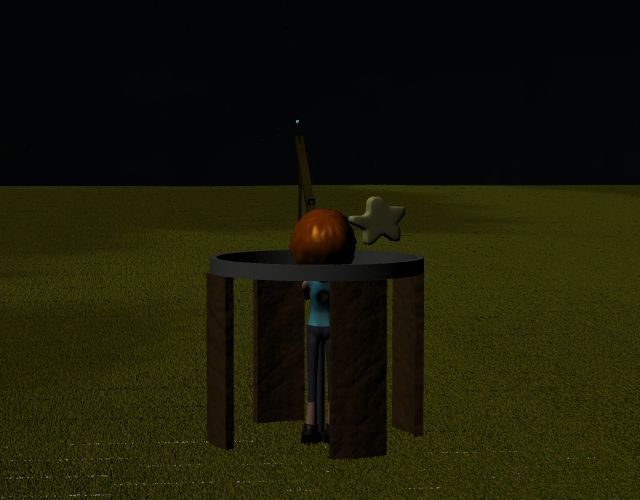
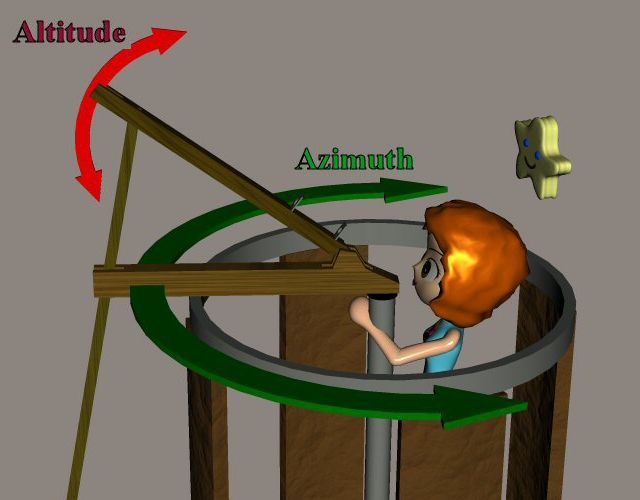 The sighting bar with two pinholes or gunsights is the alhidade. It's the key element of these instruments and astrolabes.
The sighting bar with two pinholes or gunsights is the alhidade. It's the key element of these instruments and astrolabes.
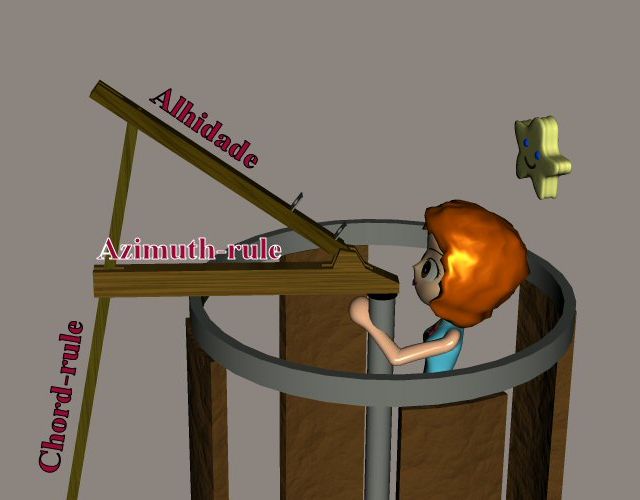 Below is a scope-like tool. It didn't include a lens; the scope was apparently just to shield your eyes from ambient light while observing moon and stars in partial daylight.
Below is a scope-like tool. It didn't include a lens; the scope was apparently just to shield your eyes from ambient light while observing moon and stars in partial daylight.
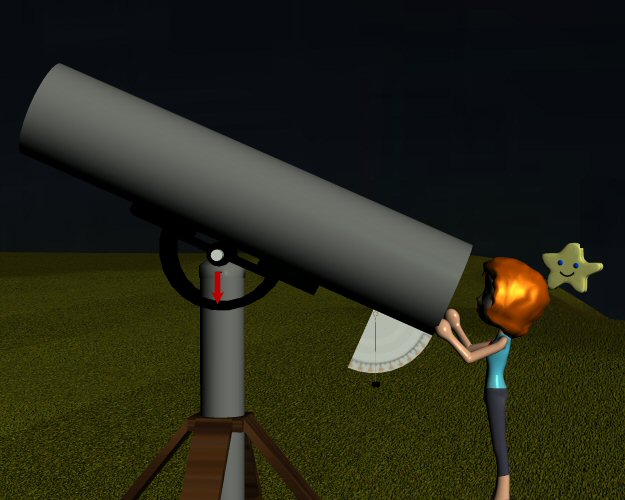
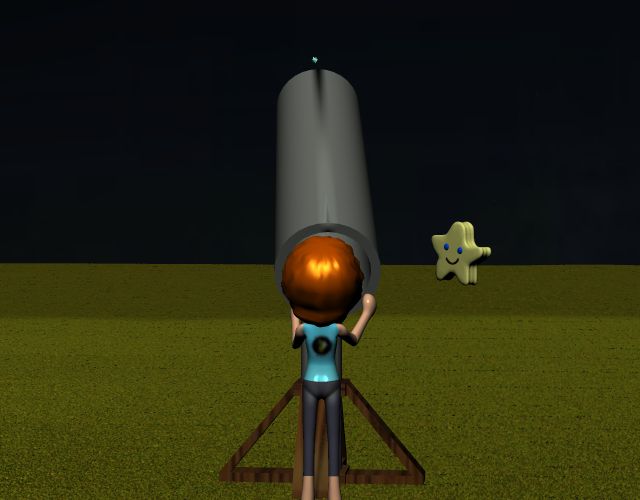 Why no lenses? My first thought was that glass wasn't available, but that's exactly wrong. Glass technology was highly developed in that part of the world 15000 years ago in the Bronze Age, and many practical and artistic glass items were found in the same place and era as the observatory. Even worse, some of the scholars who wrote about the observatory ALSO wrote in detail about glass technology. So refined glass tech was right there in the same place and in the same minds. Why didn't they look at the moon through the bottom of a bottle and think Eureka? We'll never know.
= = = = =
Later addition: Instrument 11. This one was unique in its ability to switch measurement modes.
Why no lenses? My first thought was that glass wasn't available, but that's exactly wrong. Glass technology was highly developed in that part of the world 15000 years ago in the Bronze Age, and many practical and artistic glass items were found in the same place and era as the observatory. Even worse, some of the scholars who wrote about the observatory ALSO wrote in detail about glass technology. So refined glass tech was right there in the same place and in the same minds. Why didn't they look at the moon through the bottom of a bottle and think Eureka? We'll never know.
= = = = =
Later addition: Instrument 11. This one was unique in its ability to switch measurement modes.
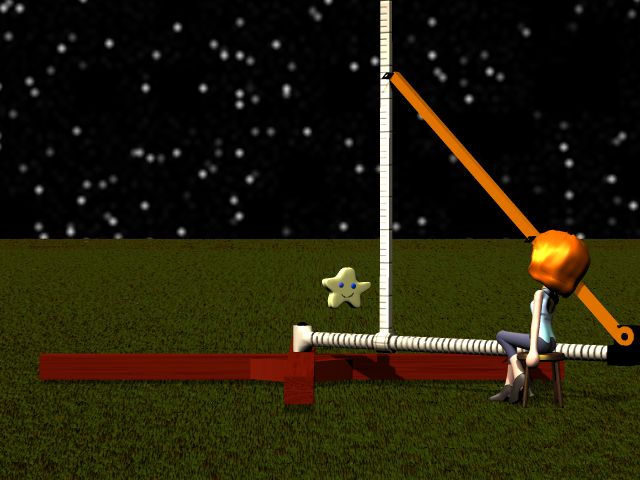 The vertical measuring stick pivoted on the horizontal rod so that it could be used two ways:
The vertical measuring stick pivoted on the horizontal rod so that it could be used two ways:
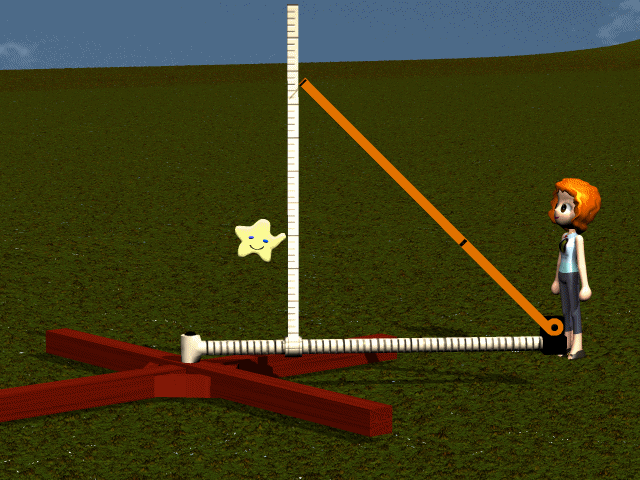 When the measuring stick was horizontal, it measured the azimuth:
When the measuring stick was horizontal, it measured the azimuth:
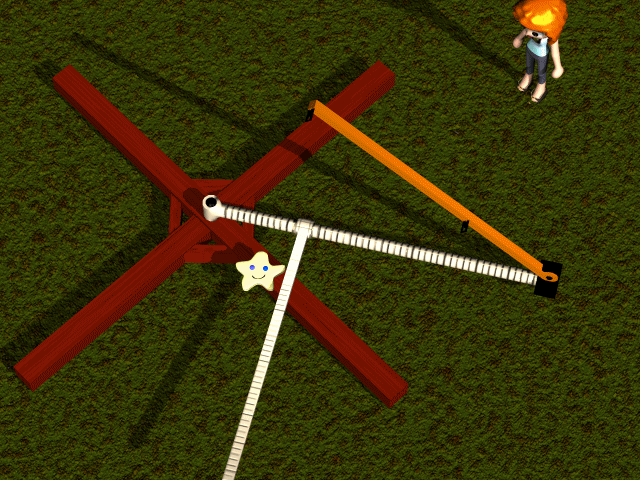 And when the measuring stick was vertical, it measured the altitude of the alidade:
And when the measuring stick was vertical, it measured the altitude of the alidade:
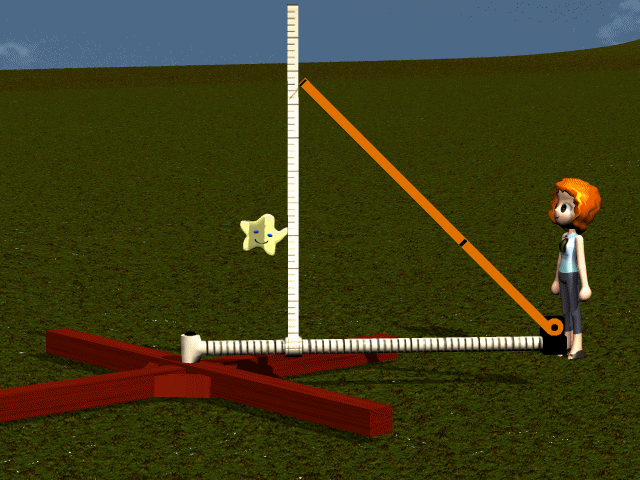 = = = = =
Here Polistra is using an astrolabe inside one of Maragha's giant azimuth dials.
= = = = =
Here Polistra is using an astrolabe inside one of Maragha's giant azimuth dials.
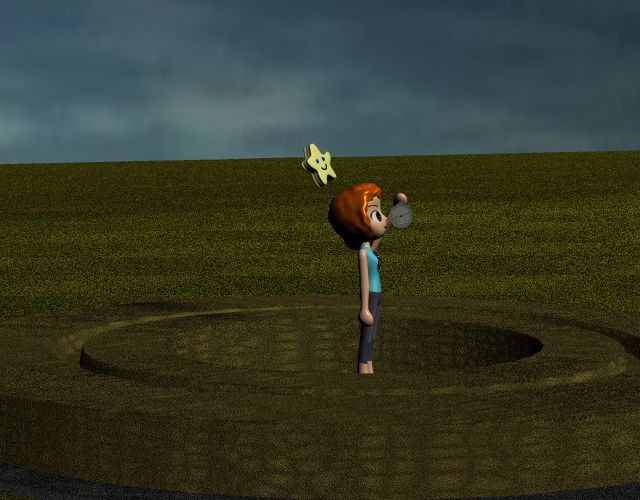 = = = = =
Astrolabe makers were highly valued and famous artisans. One of the best was a Syrian named Mariam, here in a picture from the 1001 Islamic Inventions website.
= = = = =
Astrolabe makers were highly valued and famous artisans. One of the best was a Syrian named Mariam, here in a picture from the 1001 Islamic Inventions website.
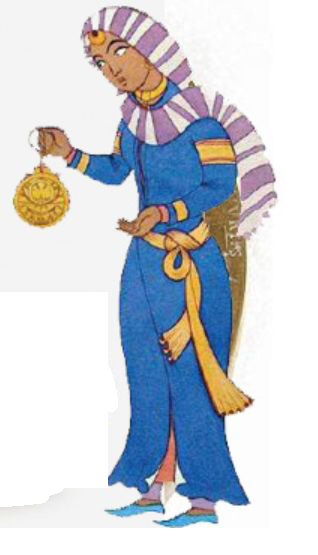 Also from that website:
Also from that website:
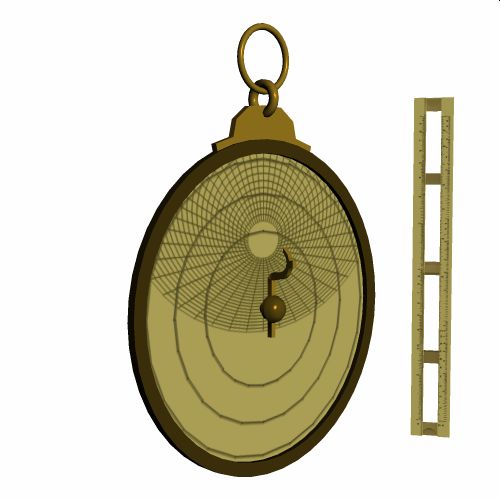 The starmap pointer is the rete (net), including specific labeled extensions for major stars. The upper circular part is used in calculations, and can be turned independently on some versions. The rete corresponds to the slider (B and C scales) on a slide rule.
The starmap pointer is the rete (net), including specific labeled extensions for major stars. The upper circular part is used in calculations, and can be turned independently on some versions. The rete corresponds to the slider (B and C scales) on a slide rule.
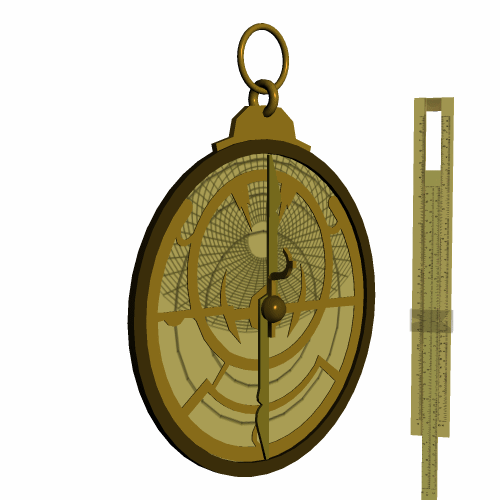 On top of the rete is the rule, corresponding to the cursor on a slide rule.
On top of the rete is the rule, corresponding to the cursor on a slide rule.
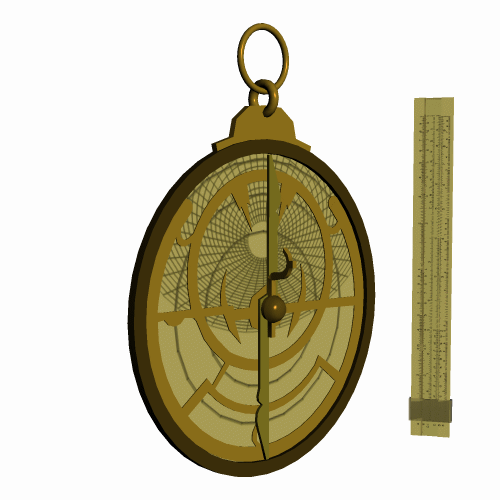 The unique part is the alhidade, on the back. As with the big instruments, you sight through the pinholes to determine height of a star or sun. You could also lay the astrolabe flat on a table or pillar, line up with north, and use the alhidade to sight an azimuth.
The unique part is the alhidade, on the back. As with the big instruments, you sight through the pinholes to determine height of a star or sun. You could also lay the astrolabe flat on a table or pillar, line up with north, and use the alhidade to sight an azimuth.
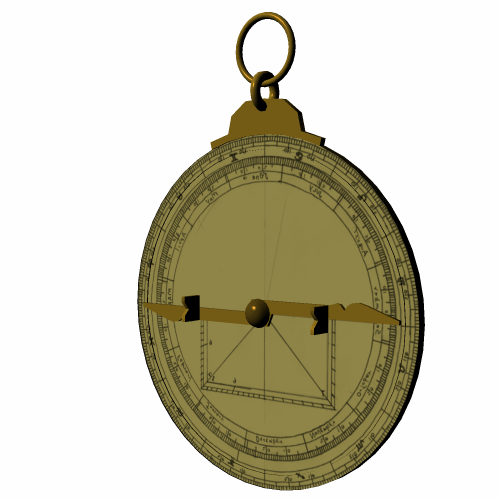 = = = = =
Jumping from 800AD to right now:
I bought an astrolabe kit from Dreipunkt in Germany. They make a variety of kits and learning toys. The kit is an interesting mix of old materials and new methods. It's entirely made of wood. Even the axle and joining pegs are wood. The wood comes in a hi-tech form, three VERY thin laminated layers, and the pieces are cut by lasers. I built it in one hour with no errors, despite my complete lack of wood skill. No tools or glue needed, except for some careful hammering of the joining pegs. Dreipunkt must have done some heavy Murphy testing on their instructions if even a wood-idiot like me can get it right!
Real astrolabes were kit-like. The horse cotterpin allowed you to remove any of the pieces, or switch the starmap plate to different maps or latitudes. Dreipunkt custom-printed a starmap for my location, labeled Spokane!
Back side with alhidade:
= = = = =
Jumping from 800AD to right now:
I bought an astrolabe kit from Dreipunkt in Germany. They make a variety of kits and learning toys. The kit is an interesting mix of old materials and new methods. It's entirely made of wood. Even the axle and joining pegs are wood. The wood comes in a hi-tech form, three VERY thin laminated layers, and the pieces are cut by lasers. I built it in one hour with no errors, despite my complete lack of wood skill. No tools or glue needed, except for some careful hammering of the joining pegs. Dreipunkt must have done some heavy Murphy testing on their instructions if even a wood-idiot like me can get it right!
Real astrolabes were kit-like. The horse cotterpin allowed you to remove any of the pieces, or switch the starmap plate to different maps or latitudes. Dreipunkt custom-printed a starmap for my location, labeled Spokane!
Back side with alhidade:
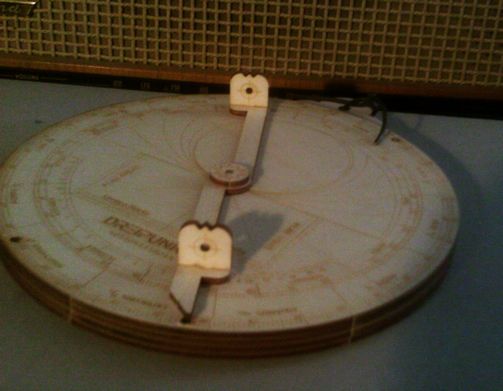 Front with rete:
Front with rete:
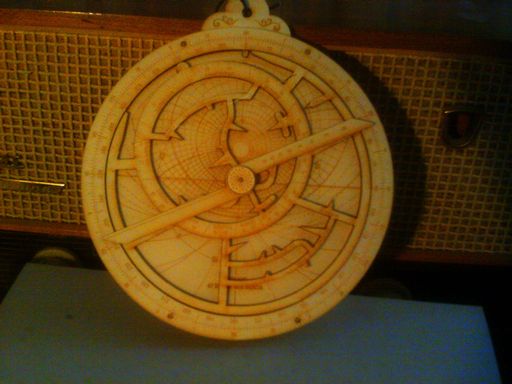 Blurry closeup of the location:
Blurry closeup of the location:
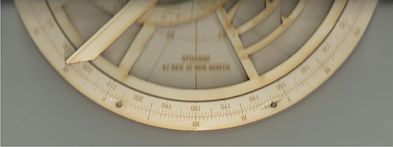 I tried following the directions to determine the time of day, which isn't really useful now but would have been routine in 800 AD before clockwork.
I used the Alhidade to measure the height of the sun over the horizon, sighting through the two pinholes. 18 degrees above horizon.
Then I re-used the Alhidade to locate the 'starsign date' from today's date. June 6 = Gemini + 16 degrees.
Then I turned the Rete to line up Gemini+16 with the great circle for 18 degrees on the Plate. 18 is between 10 and 20, with no finer lines, so this didn't feel very accurate.
Then I turned the Rule to the same Gemini+16 on the Rete, and read off the time on the Mater. Appeared to be about 6:05. The clock time when I sighted the sun was 6:13 standard time, so this isn't too bad for a first try! (Later, used an online calculator to get solar time from standard time, and the astrolabe is about 15 minutes from solar time.)
= = = = =
Astrolabes should have spawned circular slide rules but for some reason they didn't. The linear slide rule developed from Napier's Bones, and the circular slide rule or wheel chart developed much later. None of those rules included the measurement tool, so astrolabes (and their descendants like sextants) are still unique.
= = = = =
Later footnote: Yes, the horse was a cotterpin.
I tried following the directions to determine the time of day, which isn't really useful now but would have been routine in 800 AD before clockwork.
I used the Alhidade to measure the height of the sun over the horizon, sighting through the two pinholes. 18 degrees above horizon.
Then I re-used the Alhidade to locate the 'starsign date' from today's date. June 6 = Gemini + 16 degrees.
Then I turned the Rete to line up Gemini+16 with the great circle for 18 degrees on the Plate. 18 is between 10 and 20, with no finer lines, so this didn't feel very accurate.
Then I turned the Rule to the same Gemini+16 on the Rete, and read off the time on the Mater. Appeared to be about 6:05. The clock time when I sighted the sun was 6:13 standard time, so this isn't too bad for a first try! (Later, used an online calculator to get solar time from standard time, and the astrolabe is about 15 minutes from solar time.)
= = = = =
Astrolabes should have spawned circular slide rules but for some reason they didn't. The linear slide rule developed from Napier's Bones, and the circular slide rule or wheel chart developed much later. None of those rules included the measurement tool, so astrolabes (and their descendants like sextants) are still unique.
= = = = =
Later footnote: Yes, the horse was a cotterpin.

 The sighting bar with two pinholes or gunsights is the alhidade. It's the key element of these instruments and astrolabes.
The sighting bar with two pinholes or gunsights is the alhidade. It's the key element of these instruments and astrolabes.
 Below is a scope-like tool. It didn't include a lens; the scope was apparently just to shield your eyes from ambient light while observing moon and stars in partial daylight.
Below is a scope-like tool. It didn't include a lens; the scope was apparently just to shield your eyes from ambient light while observing moon and stars in partial daylight.

 Why no lenses? My first thought was that glass wasn't available, but that's exactly wrong. Glass technology was highly developed in that part of the world 15000 years ago in the Bronze Age, and many practical and artistic glass items were found in the same place and era as the observatory. Even worse, some of the scholars who wrote about the observatory ALSO wrote in detail about glass technology. So refined glass tech was right there in the same place and in the same minds. Why didn't they look at the moon through the bottom of a bottle and think Eureka? We'll never know.
= = = = =
Later addition: Instrument 11. This one was unique in its ability to switch measurement modes.
Why no lenses? My first thought was that glass wasn't available, but that's exactly wrong. Glass technology was highly developed in that part of the world 15000 years ago in the Bronze Age, and many practical and artistic glass items were found in the same place and era as the observatory. Even worse, some of the scholars who wrote about the observatory ALSO wrote in detail about glass technology. So refined glass tech was right there in the same place and in the same minds. Why didn't they look at the moon through the bottom of a bottle and think Eureka? We'll never know.
= = = = =
Later addition: Instrument 11. This one was unique in its ability to switch measurement modes.
 The vertical measuring stick pivoted on the horizontal rod so that it could be used two ways:
The vertical measuring stick pivoted on the horizontal rod so that it could be used two ways:
 When the measuring stick was horizontal, it measured the azimuth:
When the measuring stick was horizontal, it measured the azimuth:
 And when the measuring stick was vertical, it measured the altitude of the alidade:
And when the measuring stick was vertical, it measured the altitude of the alidade:
 = = = = =
Here Polistra is using an astrolabe inside one of Maragha's giant azimuth dials.
= = = = =
Here Polistra is using an astrolabe inside one of Maragha's giant azimuth dials.
 = = = = =
Astrolabe makers were highly valued and famous artisans. One of the best was a Syrian named Mariam, here in a picture from the 1001 Islamic Inventions website.
= = = = =
Astrolabe makers were highly valued and famous artisans. One of the best was a Syrian named Mariam, here in a picture from the 1001 Islamic Inventions website.
 Also from that website:
Also from that website:
The making of astrolabes, a branch of applied science of great status, was practiced by many including one woman from Aleppo, Mariam “Al-Astrolabiya” Al-Ijliya, who followed her father’s profession and was employed at the court of Sayf al-Dawlah (944 - 967 AD), one of the powerful Hamdanid rulers in northern Syria who guarded the frontier with the Byzantine empire in the tenth century.Hmm. Aleppo. Sounds familiar. Isn't that one of the horrible anti-womxn Muslim places that Hillary enlightenedly bombed down to bedrock in order to bring Enlightened Womxns Rights to the horrible primitive anti-womxn Muslims? Yes indeed, it was. I'm sure glad we got rid of those primitive simian anti-womxns. We wouldn't want any womxns to learn a useful craft. And we certainly wouldn't want a womxn to gain a justified reputation as an astronomer and instrument-maker. All womxns must spend all their time drinking to blackout, shouting incoherent Correct Slogans, and beating up peasants, following in the staggering footsteps of Our Most Noble Goddess Hillary. = = = = = Now back to the astrolabe itself. A typical astrolabe has a static mater (the outer ring) containing a separate and removable plate, the inner map. The plate could be switched out for use in different locations, or to provide a different set of curves and functions for the movable parts. The mater corresponds to the base containing A and D scales on a linear slide rule. The part that looks like a horse was called the horse for mysterious reasons. Descriptions are unclear on its function; maybe it was a cotterpin to hold the movable parts.
 The starmap pointer is the rete (net), including specific labeled extensions for major stars. The upper circular part is used in calculations, and can be turned independently on some versions. The rete corresponds to the slider (B and C scales) on a slide rule.
The starmap pointer is the rete (net), including specific labeled extensions for major stars. The upper circular part is used in calculations, and can be turned independently on some versions. The rete corresponds to the slider (B and C scales) on a slide rule.
 On top of the rete is the rule, corresponding to the cursor on a slide rule.
On top of the rete is the rule, corresponding to the cursor on a slide rule.
 The unique part is the alhidade, on the back. As with the big instruments, you sight through the pinholes to determine height of a star or sun. You could also lay the astrolabe flat on a table or pillar, line up with north, and use the alhidade to sight an azimuth.
The unique part is the alhidade, on the back. As with the big instruments, you sight through the pinholes to determine height of a star or sun. You could also lay the astrolabe flat on a table or pillar, line up with north, and use the alhidade to sight an azimuth.
 = = = = =
Jumping from 800AD to right now:
I bought an astrolabe kit from Dreipunkt in Germany. They make a variety of kits and learning toys. The kit is an interesting mix of old materials and new methods. It's entirely made of wood. Even the axle and joining pegs are wood. The wood comes in a hi-tech form, three VERY thin laminated layers, and the pieces are cut by lasers. I built it in one hour with no errors, despite my complete lack of wood skill. No tools or glue needed, except for some careful hammering of the joining pegs. Dreipunkt must have done some heavy Murphy testing on their instructions if even a wood-idiot like me can get it right!
Real astrolabes were kit-like. The horse cotterpin allowed you to remove any of the pieces, or switch the starmap plate to different maps or latitudes. Dreipunkt custom-printed a starmap for my location, labeled Spokane!
Back side with alhidade:
= = = = =
Jumping from 800AD to right now:
I bought an astrolabe kit from Dreipunkt in Germany. They make a variety of kits and learning toys. The kit is an interesting mix of old materials and new methods. It's entirely made of wood. Even the axle and joining pegs are wood. The wood comes in a hi-tech form, three VERY thin laminated layers, and the pieces are cut by lasers. I built it in one hour with no errors, despite my complete lack of wood skill. No tools or glue needed, except for some careful hammering of the joining pegs. Dreipunkt must have done some heavy Murphy testing on their instructions if even a wood-idiot like me can get it right!
Real astrolabes were kit-like. The horse cotterpin allowed you to remove any of the pieces, or switch the starmap plate to different maps or latitudes. Dreipunkt custom-printed a starmap for my location, labeled Spokane!
Back side with alhidade:
 Front with rete:
Front with rete:
 Blurry closeup of the location:
Blurry closeup of the location:
 I tried following the directions to determine the time of day, which isn't really useful now but would have been routine in 800 AD before clockwork.
I used the Alhidade to measure the height of the sun over the horizon, sighting through the two pinholes. 18 degrees above horizon.
Then I re-used the Alhidade to locate the 'starsign date' from today's date. June 6 = Gemini + 16 degrees.
Then I turned the Rete to line up Gemini+16 with the great circle for 18 degrees on the Plate. 18 is between 10 and 20, with no finer lines, so this didn't feel very accurate.
Then I turned the Rule to the same Gemini+16 on the Rete, and read off the time on the Mater. Appeared to be about 6:05. The clock time when I sighted the sun was 6:13 standard time, so this isn't too bad for a first try! (Later, used an online calculator to get solar time from standard time, and the astrolabe is about 15 minutes from solar time.)
= = = = =
Astrolabes should have spawned circular slide rules but for some reason they didn't. The linear slide rule developed from Napier's Bones, and the circular slide rule or wheel chart developed much later. None of those rules included the measurement tool, so astrolabes (and their descendants like sextants) are still unique.
= = = = =
Later footnote: Yes, the horse was a cotterpin.
I tried following the directions to determine the time of day, which isn't really useful now but would have been routine in 800 AD before clockwork.
I used the Alhidade to measure the height of the sun over the horizon, sighting through the two pinholes. 18 degrees above horizon.
Then I re-used the Alhidade to locate the 'starsign date' from today's date. June 6 = Gemini + 16 degrees.
Then I turned the Rete to line up Gemini+16 with the great circle for 18 degrees on the Plate. 18 is between 10 and 20, with no finer lines, so this didn't feel very accurate.
Then I turned the Rule to the same Gemini+16 on the Rete, and read off the time on the Mater. Appeared to be about 6:05. The clock time when I sighted the sun was 6:13 standard time, so this isn't too bad for a first try! (Later, used an online calculator to get solar time from standard time, and the astrolabe is about 15 minutes from solar time.)
= = = = =
Astrolabes should have spawned circular slide rules but for some reason they didn't. The linear slide rule developed from Napier's Bones, and the circular slide rule or wheel chart developed much later. None of those rules included the measurement tool, so astrolabes (and their descendants like sextants) are still unique.
= = = = =
Later footnote: Yes, the horse was a cotterpin.
This duty would be originally discharged by a pin with a large head at one end, and a slot at the other through which a cotteril or wedge passed to hold it in place; this wedge is sometimes made into the shape of a horse, and is so called.
Labels: Entertainment, Equipoise, Metrology, Natural law = Sharia law, new toy
